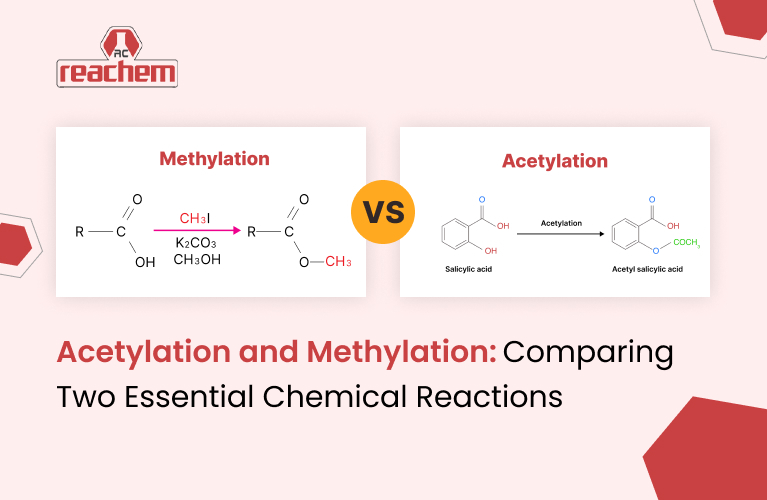wordpress-seo domain was triggered too early. This is usually an indicator for some code in the plugin or theme running too early. Translations should be loaded at the init action or later. Please see Debugging in WordPress for more information. (This message was added in version 6.7.0.) in /var/www/reachemchemicals.com/blog/wp-includes/functions.php on line 6131
In the realm of chemistry, it is crucial to comprehend the chemical reactions and processes that occur on the molecular level. Of all of the possibilities of interacting chemically, there are two significant mechanisms: acetylation and methylation. Biological receptors are involved in biological processes, and synthetic receptors are used in synthetic chemistry. In this blog, we will be discussing what acetylation and methylation involve and how and why they are important. This guide will be helpful for everyone – a student, a researcher, or even people who are interested in these two chemical reactions but do not have enough knowledge about them.
Acetylation is a process of converting or introducing an acetyl group symbolised by CH3CO into the molecule in question. This can occur in normal chemical reactions between two organic molecules. It is also used in biochemical reactions and many other systems, as well as in a number of different applications.
In organic chemistry, acetylation is employed to change the reactivity of a molecule or to make a molecule stable where necessary, when needed. Many of these reactions involve the attachment to a molecule of an acetyl group or acyl group with less than one electron. In most of its operations, however, it uses acetyl chloride or acetic anhydride as its acetylating agent.
In organic chemistry, acetylation is a versatile reagent for the preparation and modification of various compounds.
In biological systems, acetylation is also of great importance in regulating proteins and gene activity. One of the best examples of such modifications is the acetylation of histones – the proteins that are responsible for DNA compacting and structuring into chromosomal units.
There is a universal influence on the control of various cellular processes by biological acetylation. It can include gene transcription or enzymatic activity.
In organic chemistry, methylation is that action that forms a methyl, CH3, group upon a molecule. Sometimes, it needs other reagents such as methyl iodide, dimethyl sulfate, etc.
Lithiation in organic chemistry is employed in the alteration of molecules to produce different compounds termed organolithium compounds, which are used for different purposes.
In biological systems, methylation refers to one of the attachment reactions that mainly shapes the gene expression, stability of DNA and functions of protein. There are many types of methylation, but the most widely known one is DNA methylation. It entails putting in place a methyl group on the DNA molecule.
An investigation of biological methylation reveals that methylation is an essential process for the regulation of genes as well as cellular functions.
Acetylation and methylation are similar because both involve changes to molecules as well as biological processes. Both of them have many similarities and can sometimes be used interchangeably. Yet, specific differences need to be highlighted.
The particular functional group incorporated during these reactions distinguishes their chemical behaviour from their impact on the substrate.
Acetylation and methylation are both parts of the epigenetic regulation of the genes. Yet they work in direct reverse to each other.
These opposite impacts make acetylation and methylation two of the most valuable ways in the process of managing gene activity in cells.
Both acetylation and methylation have been known to have profound importance in medicine, especially in the synthesis of drugs and in therapy.
Both reactions are significant for the creation of new therapies and the elaboration of the causes and processes of diseases.
However, the concepts of acetylation and methylation are more than limited to the field of organic chemistry or biology. They also have important applications in biotechnology, which are:
In genetic engineering, gene regulation is vital for producing GMOs and proteins. Why? Regulating genes is a significant aspect of the organism’s newly designed genetic makeup.
These techniques are crucial for the generation of crops harbouring certain traits of interest and for the generation of therapeutic proteins.
Acetylation and methylation play significant roles in drug design, most especially in drugs that have an affinity to particular enzymes/genes.
It is important to comprehend such reactions so as to discover new therapies and advance the treatment processes.
Acetylation and methylation are two general chemical reactions. They play a significant role in various aspects of chemistry, biology and medicine. Both of them function in altering the molecules and controlling and coordinating biological activities. Yet, they vary in their functions and uses. To know these reactions, one can understand that life processes are not that simple within a cell and the possibility of having new technologies and cures for certain diseases.